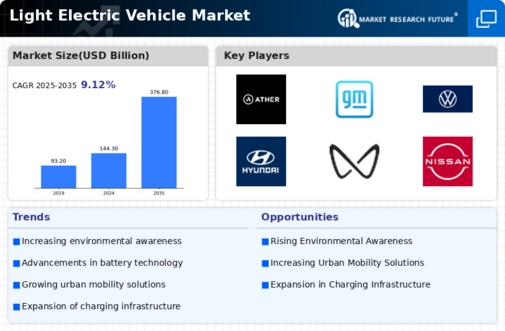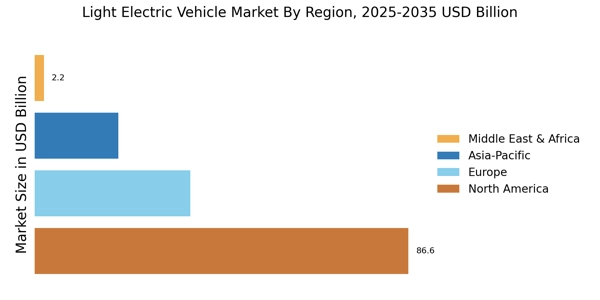Rising Fuel Prices
The Light Electric Vehicle Market is also benefiting from the rising prices of traditional fuels. As fuel costs continue to escalate, consumers are increasingly seeking alternatives that offer cost savings and efficiency. Light electric vehicles present a viable solution, as they typically have lower operating costs compared to their gasoline counterparts. The total cost of ownership for electric vehicles is becoming more attractive, with studies indicating that electric vehicle owners can save thousands of dollars over the lifespan of the vehicle. This trend is likely to drive more consumers towards light electric vehicles, further propelling the market's growth. Additionally, as more individuals become aware of the financial benefits associated with electric vehicles, the demand for light electric vehicles is expected to rise, thereby enhancing the overall dynamics of the Light Electric Vehicle Market.
Environmental Awareness
Growing environmental awareness among consumers is another pivotal factor driving the Light Electric Vehicle Market. As individuals become more conscious of their carbon footprints and the impact of fossil fuels on climate change, there is a noticeable shift towards sustainable transportation options. Light electric vehicles are perceived as a cleaner alternative, contributing to reduced greenhouse gas emissions and improved air quality. This shift in consumer behavior is supported by various campaigns and educational initiatives aimed at promoting the benefits of electric mobility. Market Research Future indicates that a significant portion of consumers is willing to pay a premium for environmentally friendly vehicles, which is likely to bolster the demand for light electric vehicles. Consequently, this heightened environmental consciousness is expected to play a vital role in shaping the future trajectory of the Light Electric Vehicle Market.
Technological Innovations
Technological advancements are a key driver in the Light Electric Vehicle Market, as innovations in battery technology, charging infrastructure, and vehicle design continue to evolve. The development of high-capacity batteries has significantly improved the range and performance of light electric vehicles, making them more appealing to consumers. Furthermore, the expansion of charging networks is addressing one of the primary concerns regarding electric vehicle adoption: range anxiety. With more charging stations being installed in urban and suburban areas, consumers are increasingly confident in their ability to use light electric vehicles for daily commutes and longer trips. This technological progress is not only enhancing the user experience but is also likely to attract new entrants into the market, thereby fostering competition and innovation within the Light Electric Vehicle Market.
Urbanization and Congestion
The increasing trend of urbanization and the associated challenges of traffic congestion are driving the Light Electric Vehicle Market. As urban populations grow, cities are facing significant transportation challenges, including overcrowded roads and pollution. Light electric vehicles offer a practical solution to these issues, as they are typically smaller, more maneuverable, and produce zero tailpipe emissions. Many urban areas are implementing policies that favor the use of electric vehicles, such as low-emission zones and incentives for electric vehicle owners. This urban-centric approach is likely to encourage more consumers to adopt light electric vehicles as a means of navigating congested city environments. As urbanization continues to rise, the demand for light electric vehicles is expected to increase, further influencing the dynamics of the Light Electric Vehicle Market.
Government Incentives and Regulations
The Light Electric Vehicle Market is experiencing a surge in demand due to favorable government incentives and regulations. Many countries are implementing policies that promote the adoption of electric vehicles, including tax credits, rebates, and grants for consumers and manufacturers. For instance, in several regions, governments are setting ambitious targets for reducing carbon emissions, which often include mandates for electric vehicle sales. This regulatory environment not only encourages consumers to consider light electric vehicles but also incentivizes manufacturers to innovate and expand their offerings. As a result, the market is projected to grow significantly, with estimates suggesting a compound annual growth rate of over 20% in the coming years. Such supportive measures are likely to play a crucial role in shaping the future landscape of the Light Electric Vehicle Market.


















Leave a Comment